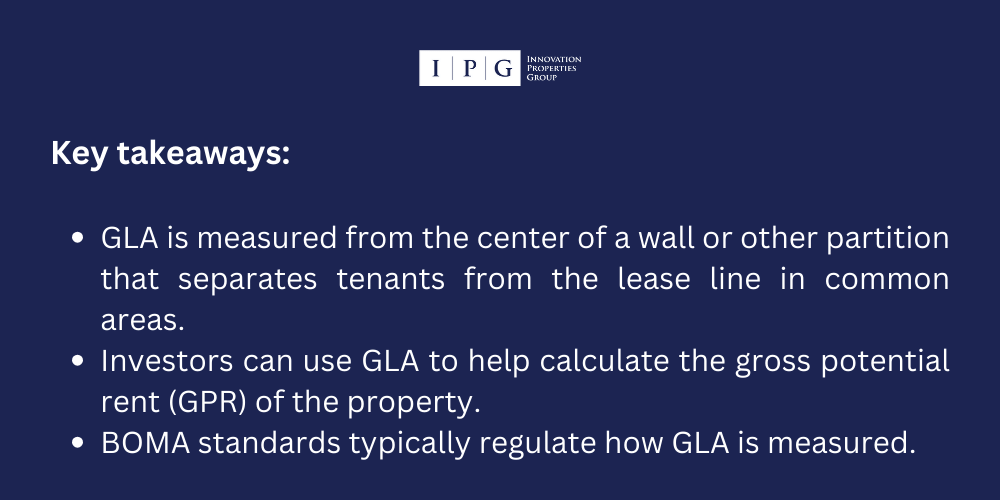Landlords usually charge rent and state the square footage of office buildings based upon the “gross leasable area” of the whole office building and of the tenant’s leased space.
Because of that, Gross Leasable Floor Area can sometimes cause difficulties for tenants, as they may think that their space actually contains those measurements.
Gross leasable area, or GLA, is the amount of space in a commercial building that can actually be rented by a tenant.
In reality, the gross leasable area of a building includes all the common areas, elevators, common bathrooms, stairwells, and other portions of the building that the tenant doesn’t occupy (regularly).
The actual square footage of the tenant’s space is called the Net Rentable Area of the building.
GLA Definition: What Is GLA?

GLA, known as gross leasable area, is a measure of the total usable interior space in a real estate property. Floors and areas that are used for tenant-oriented business activity or shopping make up GLA.
The gross leasable area measurement focuses on the total usable floor space that generates rental income.
Common areas such as hallways and restrooms are typically included in GLA, but depending on their usage, certain other areas such as elevator shafts and stairwells may be excluded.
Gross leasable area is an important factor when assessing the commercial value of a property because it indicates how much tenant rental income can be generated for the property’s owner.
Gross Leasable Area Vs. The Amount Of Net Rentable Space
Almost without exception, the gross leasable area of a tenant’s space is larger than the actual physical measurements of the space.
Thus, that 5,000 sq. ft. office space you’ve been looking to lease – is not, in fact, 5,000 sq. ft. Rather it’s more around 4,300, or 4,500, or 4,700 – depending on the particular building and the amount of non-rentable space that’s being included in the estimates.
I’ve seen tenants do drawings of their floorplans to see how their company is going to fit into a space, and they get surprised.
When you are budgeting for your new office space, be sure to take into account the difference between the gross leasable area of your space and the net rentable area.
In Case You Need an Office Space

Full building event space with private rooms for meetings/calls, high-ceiling creative aesthetic.

Potrero Hill Creative Office & Warehouse
Gross Leasable Area or Net Leasable Area?
Does the tenant need to pay rent based on Gross Leasable Area or Net Leasable Area?
In the vast majority of cases, the tenant will have to GLA pay based upon the gross leasable area of the building.
It does not have so much to do with whether you want to pay for your share of the common area, rather with how pricing models have developed over the years, decades now.
If you want to lease a space, the pricing is based on the gross leasable area, and you simply aren’t going to be able to lease space from the landlord. They also have models in which they calculate their return on investment on a given property.
As investors, they require that minimum return to invest in a commercial real estate asset. If they gave the tenants rents based upon the net rentable area – they would simply adjust the per square foot rents upward, and meet their target ROIs.
So, yes, in most cases, you as a tenant will be paying your rent based on Gross Leasable Area because you are responsible for a portion of the common area.
GLA And Gross Potential Rent
Understanding the Gross Leasable Area (GLA) and Gross Potential Rent (GPR) is crucial for investors looking to determine the profitability of a property. By calculating GPR using the GLA and market rent/sq. ft, investors can gain valuable insights into potential rental income.
For example…
If the annual market rent for a certain building is estimated at $10/sq. ft., and the building’s GLA is 20,000 sq. ft., then the annual GPR of the building would be $200,000.
However, it’s important to note that occupancy rates can significantly impact the final rental income, so it’s essential to weigh all factors before making investment decisions.
BOMA Standards – How Gross Leasable Area is Measured
Knowing how to measure gross leasable area (GLA) according to BOMA standards is a crucial part of commercial and office property management.
The Building Owners and Managers Association defines GLA as any individual rooms or portions of a room that a person can lease or use to generate income.
This includes common areas such as lobbies and hallways along with tenant spaces, which should include all usable square footage such as lobbies, restrooms, closets and operable partitions within tenant occupied areas. BOMA’s standard method for measuring GLA requires beginning on the structural perimeter and working inwards, calculating floor area that adheres to the definition provided above.
When determining square footage, you must factor in any obstacles like pillars or inset walls, and this will result in an accurate measurement that you can use for reporting purposes.
Proper measurement through BOMA standards ensures tenants have an accurate impression of the property value they will receive for their lease agreement.

For specific questions about how a part of a building may be included in its gross leasable area, consult IPG for more information. To learn more about commercial real estate leases, speak with an IPG specialist today.
















